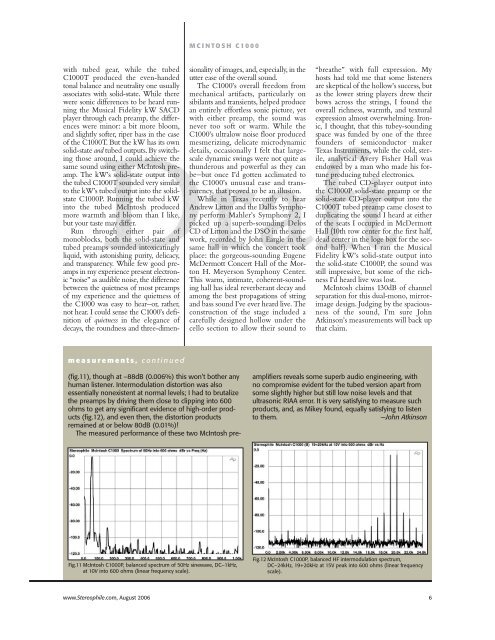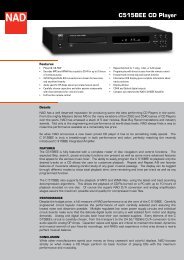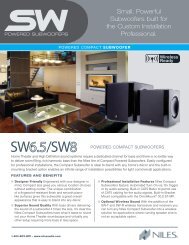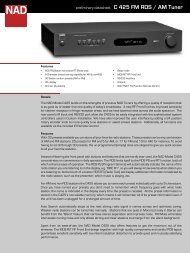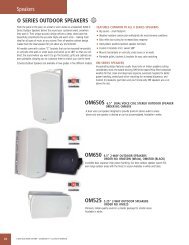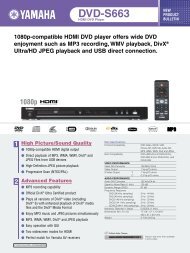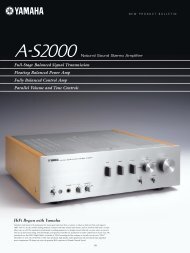MCINTOSH <strong>C1000</strong>with tubed gear, while the tubed<strong>C1000</strong>T produced the even-handedtonal balance and neutrality one usuallyassociates with solid-state. While therewere sonic differences to be heard runningthe Musical Fidelity kW SACDplayer through each preamp, the differenceswere minor: a bit more bloom,and slightly softer, riper bass in the caseof the <strong>C1000</strong>T. But the kW has its ownsolid-state and tubed outputs. By switchingthose around, I could achieve thesame sound using either <strong>McIntosh</strong> preamp.<strong>The</strong> kW’s solid-state output intothe tubed <strong>C1000</strong>T sounded very similarto the kW’s tubed output into the solidstate<strong>C1000</strong>P. Running the tubed kWinto the tubed <strong>McIntosh</strong> producedmore warmth and bloom than I like,but your taste may differ.Run through either pair ofmonoblocks, both the solid-state andtubed preamps sounded intoxicatinglyliquid, with astonishing purity, delicacy,and transparency. While few good preampsin my experience present electronic“noise” as audible noise, the differencebetween the quietness of most preampsof my experience and the quietness ofthe <strong>C1000</strong> was easy to hear—or, rather,not hear. I could sense the <strong>C1000</strong>’s definitionof quietness in the elegance ofdecays, the roundness and three-dimensionalityof images, and, especially, in theutter ease of the overall sound.<strong>The</strong> <strong>C1000</strong>’s overall freedom frommechanical artifacts, particularly onsibilants and transients, helped producean entirely effortless sonic picture, yetwith either preamp, the sound wasnever too soft or warm. While the<strong>C1000</strong>’s ultralow noise floor producedmesmerizing, delicate microdynamicdetails, occasionally I felt that largescaledynamic swings were not quite asthunderous and powerful as they canbe—but once I’d gotten acclimated tothe <strong>C1000</strong>’s unusual ease and transparency,that proved to be an illusion.While in Texas recently to hearAndrew Litton and the Dallas Symphonyperform Mahler’s Symphony 2, Ipicked up a superb-sounding DelosCD of Litton and the DSO in the samework, recorded by John Eargle in thesame hall in which the concert tookplace: the gorgeous-sounding EugeneMcDermott Concert Hall of the MortonH. Meyerson Symphony Center.This warm, intimate, coherent-soundinghall has ideal reverberant decay andamong the best propagations of stringand bass sound I’ve ever heard live. <strong>The</strong>construction of the stage included acarefully designed hollow under thecello section to allow their sound to“breathe” with full expression. Myhosts had told me that some listenersare skeptical of the hollow’s success, butas the lower string players drew theirbows across the strings, I found theoverall richness, warmth, and texturalexpression almost overwhelming. Ironic,I thought, that this tubey-soundingspace was funded by one of the threefounders of semiconductor makerTexas Instruments, while the cold, sterile,analytical Avery Fisher Hall wasendowed by a man who made his fortuneproducing tubed electronics.<strong>The</strong> tubed CD-player output intothe <strong>C1000</strong>P solid-state preamp or thesolid-state CD-player output into the<strong>C1000</strong>T tubed preamp came closest toduplicating the sound I heard at eitherof the seats I occupied in McDermottHall (10th row center for the first half,dead center in the loge box for the secondhalf). When I ran the MusicalFidelity kW’s solid-state output intothe solid-state <strong>C1000</strong>P, the sound wasstill impressive, but some of the richnessI’d heard live was lost.<strong>McIntosh</strong> claims 130dB of channelseparation for this dual-mono, mirrorimagedesign. Judging by the spaciousnessof the sound, I’m sure JohnAtkinson’s measurements will back upthat claim.measurements, continued(fig.11), though at –88dB (0.006%) this won’t bother anyhuman listener. Intermodulation distortion was alsoessentially nonexistent at normal levels; I had to brutalizethe preamps by driving them close to clipping into 600ohms to get any significant evidence of high-order products(fig.12), and even then, the distortion productsremained at or below 80dB (0.01%)!<strong>The</strong> measured performance of these two <strong>McIntosh</strong> preamplifiersreveals some superb audio engineering, withno compromise evident for the tubed version apart fromsome slightly higher but still low noise levels and thatultrasonic RIAA error. It is very satisfying to measure suchproducts, and, as Mikey found, equally satisfying to listento them.—John AtkinsonFig.11 <strong>McIntosh</strong> <strong>C1000</strong>P, balanced spectrum of 50Hz sinewave, DC–1kHz,at 10V into 600 ohms (linear frequency scale).Fig.12 <strong>McIntosh</strong> <strong>C1000</strong>P, balanced HF intermodulation spectrum,DC–24kHz, 19+20kHz at 15V peak into 600 ohms (linear frequencyscale).www.<strong>Stereophile</strong>.com, August 2006 6
MCINTOSH <strong>C1000</strong>Phono preamps: tube vssolid-stateWith premium phono preamps costingas much as the <strong>C1000</strong>C controller plusone of the preamps, you might thinkthat the <strong>C1000</strong>T’s and <strong>C1000</strong>P’s builtinphono stages are mere afterthoughts.That didn’t prove to be the case. Boththe solid-state and tubed phono preampssounded exceptionally fine, andmaintained the line sections’ exceptionalquiet, coherence, harmonic completeness,delicacy, and dimensionality.However, only higher-output lowoutputMCs should be used. Fortunately,top-of-the-line cartridges withoutputs of 0.45mV, such as the LyraTitan i, are currently in vogue, as moreand more manufacturers finding waysto increase output without loweringresolution. <strong>The</strong> low noise floor of eventhe <strong>C1000</strong>T’s tubed phono sectionpermitted the use of lower-output cartridgeswithout making the dynamicssuffer. At least, that’s what I foundusing the luscious-soundingMiyabi/47 Labs cartridge with eitherphono preamp. But I wouldn’t golower than the Miyabi’s output of0.3mV.Joni Mitchell’s Blue (LP, RepriseMS 2038)—which I’ve been playing alot lately—proved the perfect foil foreither preamp’s phono section, withmy nod going to the 12AX7-based<strong>C1000</strong>T for its extra touches of delicacyand suppleness. With a finesense of studio acoustic, a real senseof hearing Mitchell before the microphonetakes her voice, and a guitarutterly believable in both image andharmonics, I can’t say I’ve heard thisrecord sound more satisfying.Each phono preamp delivered aninviting, delicate rendering ofacoustic music without wimping outon amplified material. <strong>The</strong> tubed<strong>C1000</strong>T’s phono preamp managedwarmth without enveloping thelower midrange in a blanket, and thesolid-state <strong>C1000</strong>P delivered detailwithout astringency.I also compared the <strong>C1000</strong>T and<strong>C1000</strong>P using the superb-soundingAtaulfo Argenta Edition, a boxed set ofLPs collecting the recordings of theSpanish conductor, who died in 1958at the age of 44 (Alhambra/Alto AnalogueAA006, out of print). Don’t listento the carpers who say that onlythe original—and impossible to find—Spanish edition will do. If you findthe Alto Analogue, don’t pass it up. Icompared this set’s edition of Argentaand guitarist Narciso Yepes’ recordingof Rodrigo’s Concierto de Aranjuez with aLondon “Blueback” ffss edition (CS6046), and while they were different, Icould make a case for either one. <strong>The</strong>Alto offered greater transparency and amore forward perspective; the Londonhad me sitting farther back in the hall.In any case, the tubed <strong>C1000</strong>T gaveYepes’ guitar a rich, delicate, andvibrant “golden” tonality, the solidstate<strong>C1000</strong>P a bit more transient fire—but this was only a change of seasoning,not a different entrée. That oneseasoning was produced by eight12AX7s and the other by transistors,and that both sounded so remarkablysimilar, especially in terms of harmonicstructure, is a testament to <strong>McIntosh</strong>Laboratory’s honest attempt in the<strong>C1000</strong> to not “flavor” the sound to suitpreconceived notions of what eithertechnology should deliver.ASSOCIATED EQUIPMENTANALOG SOURCES ContinuumAudio Labs Caliburn turntable; ContinuumCobra, Graham Phantomtonearms; Lyra Titan (stereo &mono), Miyabi/47 Labs cartridges.DIGITAL SOURCES Musical FidelitykW SACD player, Alesis MasterlinkBPT-modified hard-disk recorder.PREAMPLIFICATION Manley Steelhead,Blue Amp 42, PS Audio GCPH,Oracle Temple phono preamplifiers.POWER AMPLIFIERS Musical FidelitykW, mbl 9007 monoblocks.LOUDSPEAKERS Wilson MAXX 2,Merlin VSM.CABLES Phono: CrystalConnect Piccolo.Interconnect: Acrolink 6100,Shunyata Research Antares, TransparentAudio Reference, Harmonic TechnologyMagic Link One balanced.Speaker: Shunyata Research Orion,Transparent Reference. AC: JPS,Shunyata Research.ACCESSORIES Shunyata ResearchHydra 2, Hydra 8 power conditioners;Halcyonics Micro 40 active isolator;Continuum Castellon magneticisolation stand, Finite ElementePagode equipment stands; AudiodharmaCable Cooker; ASC TubeTraps, RPG BAD & Abffusor panels,Hallograph Sound Field Optimizers;VPI HW-17F, Loricraft PRC4 Deluxerecord-cleaning machines.—Michael FremerConclusions<strong>The</strong> <strong>McIntosh</strong> <strong>C1000</strong> is a complexmachine. Its flexibility is almost unlimited,and while some audiophiles believethat simplicity equals sonic purity, in thecase of the <strong>C1000</strong> you can have both.Chances are you’d never use all of itsfeatures, but that doesn’t mean you’d bewasting your money. Combine the<strong>C1000</strong>C controller with either preamplifierand you have a full-function preampof the highest order. You couldalways add the other preamp later; then,in addition to having sufficient inputsfor your and your neighbor’s stereos,you’d be able to season your system’scomponents to perfection.Configuring the <strong>C1000</strong> was complicatedand occasionally frustrating, butif you like puzzles, you’ll enjoy playingwith it. If you don’t, make sure yourdealer sets it up to your liking and iswilling to visit as needed to reconfigureit. Given these prices, it’s the least heshould be willing to do.<strong>The</strong> <strong>McIntosh</strong> <strong>C1000</strong> combinesultralow noise and ultralow distortionwith transparency, harmonic completeness,and, thanks to its ultralow noisefloor, resolution of low-level microdynamicsthat is unprecedented in myexperience. It delivered unrivaledimage specificity without unnaturaledge, layer on layer of detail, transientspeed and purity without soundinghyper, and delicacy and supplenesswithout sounding soft and soupy.While the tubed <strong>C1000</strong>T’s bass wasslightly less well controlled {than the<strong>C1000</strong>P’s?}, it compensated with texturalsuppleness. While the solid-state<strong>C1000</strong>P’s bass was not quite as suppleas the <strong>C1000</strong>T’s, it compensated withmuscular control. Yet it wasn’t the casethat one was mushy and the othermechanical. <strong>The</strong> <strong>C1000</strong> was like agreat dish whose individual ingredientsyou can’t taste—you just enjoy the finalblend of flavors without wanting moreor less of anything.Aside from its exquisite sound, the<strong>C1000</strong> is impeccably designed, engineered,and built. In terms of its dayto-dayoperation—turn-on, warmup,switching—the <strong>C1000</strong> performed likethe premium-priced luxury product itis (something that can’t be said of allexpensive audio gear). That it’s madein the USA by a company foundedmore than 50 years ago, is a reassuringthought even for those who can’tafford it. For you who can, it demandsyour attention.■■www.<strong>Stereophile</strong>.com, August 2006 7


